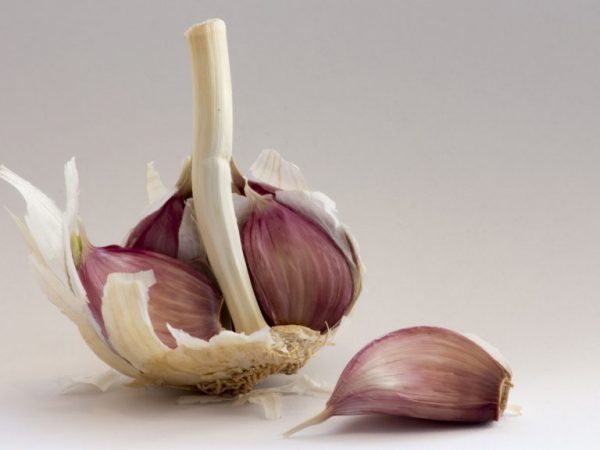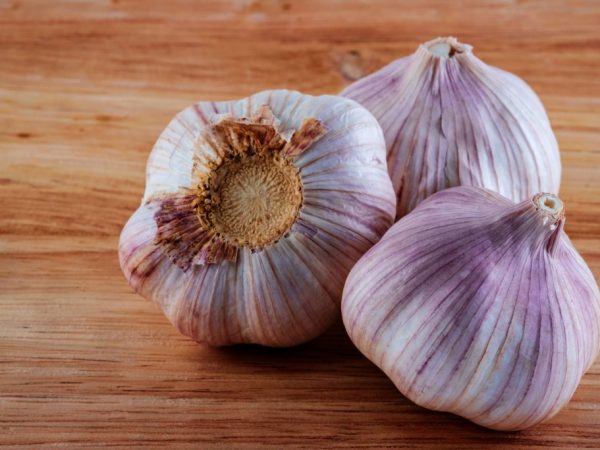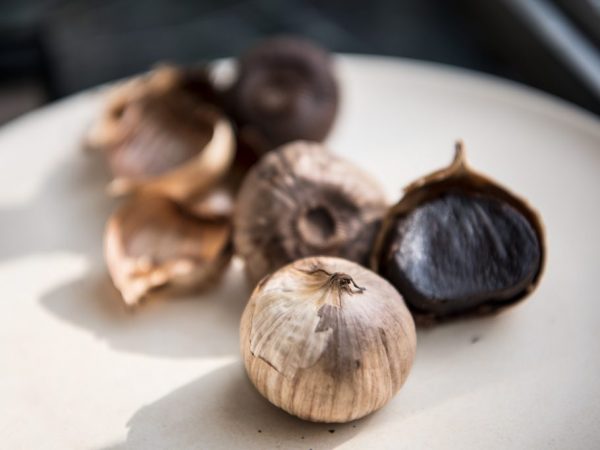Characteristics of garlic
Garlic is not only a piquant spice, but also a natural storehouse of useful microelements. This vegetable is successfully used for cooking, strengthening the body, preventing and treating diseases. Let's consider the properties of garlic in more detail: its composition, useful qualities, cultivation and methods of application.

Characteristics of garlic
Vegetable characteristic
Garlic is a perennial herb that belongs to the bulbous family. It is usually divided into white and pink (red). The number of garlic cloves can be different (depending on the variety) - from 3 to 20. The plant usually reaches a height of 60 cm, but there are also low-growing varieties with a height of about 30 cm. The main feature of the vegetable is a pungent piquant taste and a specific pungent smell.
Not only cloves of garlic are suitable for consumption, but also its leaves, arrows and flowers. The calorie content of the product is 149 kcal per 100 g. It contains an abundance of carbohydrates, proteins, vitamins, minerals, essential oils, valuable acids and organic compounds. In addition, more antioxidants can be found in garlic.
Healing properties
- It has long been known about the bactericidal properties of garlic. Garlic contains many biologically active substances: phytoncides, sulfides, allicin. They kill pathogenic bacteria, help to cope with viral, fungal and infectious diseases. (Garlic is extremely useful for ARVI, various colds and coughs, asthma, diphtheria, intestinal infections). In addition, preparations with this vegetable perfectly disinfect wounds and promote rapid tissue healing.
- Thanks to its antioxidant content, the vegetable has the ability to fight against tumors. In addition, antioxidants give garlic anti-aging properties and the ability to better resist the body.
- Garlic is used to normalize heart function (for example, with angina pectoris) and improve vascular function. The allicin contained in the vegetable helps to cope with hypertension and cholesterol. This is another reason why consuming garlic is recommended for healthy lifestyle management.
- Traditional medicine recommends the consumption of garlic for men. This vegetable successfully increases testosterone levels and, as a result, male sexual function. In addition, its consumption is a good prevention of inflammation of the urogenital organs (male and female).
- In folk and official medicine, the plant is often used to get rid of worms. A clove of garlic per day is considered a good prevention of worms.
To strengthen the body
Calcium, magnesium, silicon, phosphorus, sodium, copper, iron, zinc, selenium and other trace elements, as well as valuable vitamins contained in this vegetable, help to strengthen and improve the body. Daily consumption of a clove of garlic leads to improved immunity, it helps the digestive tract and gallbladder to function.This product is also recommended as an effective and environmentally friendly disease prevention tool. Plus, it is a good stimulant of appetite and metabolism in the body.
Thanks to the thiamine content, the vegetable strengthens the nervous system and helps to get rid of insomnia. It is scientifically proven that garlic has the ability to improve memory, especially in the elderly. The vegetable is good for dental and oral health, especially when baked.
Contraindications

Garlic is best avoided for a sore stomach.
Garlic is contraindicated for people with ulcers or gastritis. This vegetable should not be used for pancreatitis, kidney and liver diseases, as well as at the stage of exacerbation of hemorrhoids. Garlic is contraindicated in case of anemia (anemia), it is undesirable to consume it in case of bleeding. The product should not be eaten in case of epilepsy, as it can provoke another seizure.
It should be handled with care while dieting and obese. Contraindications to this vegetable also apply to the period of pregnancy and lactation.
Garlic should not be overused (it is enough to eat 2-4 cloves per day). Before resorting to medications based on this vegetable, infusions or decoctions, you should discuss this decision with your doctor and in no case self-medicate.
Application methods
It is healthier to eat fresh garlic than frozen, dried, soaked, or cooked. During processing (and even just long-term storage in cut form), the vegetable loses its healing properties: most of the vitamins and beneficial compounds are destroyed.
- When adding a vegetable to pilaf, spaghetti, vegetable and meat dishes, it is better not to cut the cloves, but to crush. This approach will help preserve the healing properties, taste and aroma of the seasoning.
- To strengthen the immune system, you can prepare a healthy and tasty garlic oil: add chopped cloves to olive oil and strain after a day or two. The resulting infusion is recommended to be used for dressing salads.
- You can eliminate garlic odor from the mouth and wash your hands from it using a slice of lemon or lemon juice. Mint is a fairly effective remedy, as well as parsley. Dishes after garlic dishes are advised to be cleaned with mustard or washed with soap and soda solution.
- Medicinal uses of this product include inhalation to help relieve colds and coughs. Garlic vapors have medicinal properties provided fresh, freshly grated vegetable is used. You can breathe in pairs before going to bed, covered with a towel, or just put a saucer of water next to you, adding 1-2 chopped cloves to it (after a couple of hours, the contents of the saucer are replaced with a fresh one).
- When applied externally, garlic gruel must be used with caution (for the treatment of boils, seborrhea, mycoses, etc.) or the products in which it is included. Garlic of too bitter varieties should not be used, as the increased severity will provoke burns.
- It is better to freeze a vegetable for the winter in the form of peeled cloves or chopped (separately or in combination with herbs). Do not freeze whole heads: once they are defrosted, it will be difficult to clean them.
Varieties

Choosing the right garlic
Growing type
There are three types of garlic according to the method of cultivation.
Winter arrow garlic
The first group includes winter garlic capable of producing an arrow (Parus, Lyubasha, Leader, etc.). Most often it is a hot vegetable with excellent yield, but low keeping quality.
Winter non-shooting garlic
The second group includes a winter vegetable that does not form an arrow (Ukrainian White, Lekar, Saki, etc.). It is a less pungent plant that also has high yields.
Spring garlic
The third group includes spring varieties that do not give shooters (Victorio, Yelenovsky, etc.). They are distinguished by a mild sweetish-spicy taste and excellent keeping quality, however, the yield of this group is slightly lower than the first two.
Size and shape
Vegetables are also divided into three groups, depending on the weight and size of the bulbs:
- Small garlic, the head of which weighs less than 20 g, medium - from 20 to 30 g.
- Large - the head weighs over 30 g.
- Giant varieties, the bulbs of which reach a weight of 250 g, and some - 500 g (Yellow giant, Alekseevsky, Gulliver, etc.). On average, from one hundred square meters of plantings of this kind, you can get 200-300 kg of harvest.
Of particular interest is the so-called onion garlic, the taste and appearance of which combines the qualities of each of the vegetables: both onions and garlic (Rocambol, Mountain garlic, etc.).
Agrotechnics
Plot
The area in the garden where the garlic will be planted should be flat and well lit. The vegetable is very picky about the condition of the soil - the ground should not be dry or too wet. The vegetable grows best on low elevations (this gives it a lot of light and avoids waterlogging). The culture is very fond of fertile soil (sandy loam or loamy - it must be generously supplied with organic fertilizers).

You need to know how to store garlic
The site must be processed 1.5 months before planting (get rid of weeds and apply fertilizers). According to the requirements of crop rotation, this vegetable is planted after early cucumbers and cabbage, early tomatoes and potatoes, early greens. The crop is planted with separate cloves or small onions (if grown on a green feather) in rows. The distance between the rows is 40-45 cm, between the holes - 7 cm; planting depth - 6 cm.
Care
Care measures include weeding and loosening the soil between rows, watering and fertilizing. The formation of plant roots occurs quickly enough, so it needs a well-moistened soil (2-3 waterings per week). After the bulb is formed, it can be watered less often; watering is stopped 3 weeks before harvesting.
Ripening signs
- The scales become thinner and dry, redden or take on a different color inherent in this variety.
- When the arrows are cut off, the lower leaves of the plant become dry, and the upper leaves turn yellow.
- On the arrows, the shells of the air bulbs burst, showing the seeds.
- The main bulb of the plant becomes fully formed, with visible outlines of denticles, with dense and smooth scales.
Cleaning
When there are signs of ripening, the crop can be harvested. Selected vegetables are laid out in rows for drying and airing. In hot weather, the heads are covered with leaves to avoid burns. For storage, clean, dry and healthy bulbs are selected, cutting the tops of up to 5 cm, shooters - up to 1 cm.
Storage
Typically, the heads are stored in a basement at temperatures between 10 ° C and 15 ° C. To preserve the vegetable as long as possible, it is placed in a place with a temperature of 0-1 ° C, spoiled and sprouted specimens are regularly examined and removed. For daily use, you can make beautiful braids from garlic heads with your own hands. Hanging in the kitchen, such a braid will effectively complement the interior and will always be in the access zone. In addition, the vegetable can be stored in the refrigerator in perforated polyethylene bags.
Growing tips
- When cultivating a vegetable garden, it is necessary to properly plan the planting of garlic in relation to other crops in order to get the most benefit from their compatibility. The vegetable will provide additional benefits if it is adjacent to potatoes, strawberries or carrots. It will protect potatoes from late blight, and strawberries and carrots from harmful insects. It will also be useful next to cucumbers and tomatoes, currants and raspberries.
- Being a moisture-loving vegetable, garlic is great for hydroponic cultivation in greenhouses, hotbeds and even at home. However, for full growth, he needs good lighting. Supplementary lighting is desirable (especially in winter, when the night becomes longer than the day).
- Sometimes garlic plantings get sick, which is reflected in the gradual yellowing of green leaves. Improper care or pests may be the cause.In order to avoid the first planting, they provide regular watering, temperature conditions and loosening. In order not to collide with the second, spraying with a solution of copper sulfate (1%) is used at the stage when young shoots reach 2-3 cm.
- Often this vegetable is affected by green, blue or black mold. To avoid this disease during the storage stage, the heads are regularly inspected and all, at least somewhat damaged, removed. It is necessary to ensure that the temperature and humidity in the room do not rise above normal. People use cloth bags to store garlic, pre-soaked in saline.
- It is not recommended to pull out incompletely ripe bulbs, as nitrate levels rise shortly before final maturity.


